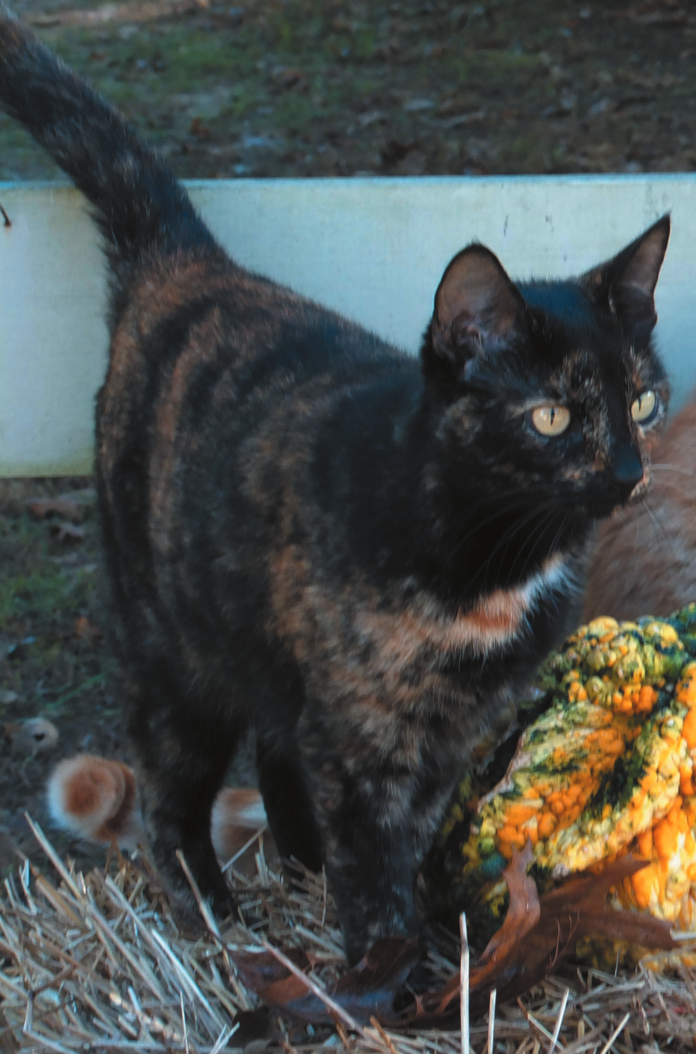A number of years ago, psychology researchers asked almost 200 people to assign personality traits to their cats. Among the choices: aloof, bold, calm, friendly, shy, stubborn, and tolerant.
The investigators’ finding, laid out in the journal Anthrozoos: people tended to rate orange cats and cats of two colors as friendly. But cats of three colors — calicos or tortoiseshells — were considered antisocial. Tortoiseshells were also considered intolerant and trainable — two traits that pretty much seem mutually exclusive.
White cats and black cats, too, were called antisocial, and white felines were also described as not so bold and active but rather sly, lazy, calm, and aloof. Black cats were said not to exhibit traits in the extreme.
Is there anything to it? Well, a few years later, other researchers published a similarly themed study in the Journal of Applied Animal Welfare Science. Querying almost 1,300 cat guardians, they found that respondents felt orange cats were particularly aggressive toward people during everyday interactions as well as on veterinary visits.
With one study suggesting that orange cats are friendly and another that they are aggressive, we surmise that, at best, the jury is out on whether color is correlated with a cat’s temperament and, more likely, that color and personality traits are not genetically linked — or certainly not linked in a sturdy enough way to definitively tie a cat’s color to its personality style.
Says the head of the Tufts Animal Behavior Clinic, Stephanie Borns-Weil, DVM, “associating hair color with personality doesn’t happen only with cats. Historically, redheads have been considered hotheads, and blondes are purported to have more fun.
“It is scientifically plausible that color traits could be linked to behavioral traits,” she adds. Studies comparing specific behavioral traits and coat color among cats may well turn out to reveal links between the way cats look and the way they act. But general perceptions connecting appearance to personality are more apt to reflect people’s preconceived notions about color and personality. That is, people’s preconceptions about feline appearance and behavior are revealing, but not necessarily about cats.
Even if coat color does turn out to be associated with a higher prevalence of certain behaviors, “many other things influence personality in a decidedly influential way,” Dr. Borns-Weil says. For instance, a cat’s early environment, accumulated experiences, state of health, and other generic contributions from her parents have a lot to do with whether she takes a shine to humans.
How our perceptions matter
While you can’t necessarily tell anything about a cat’s personality by its color, it’s worth noting that one study found black and brown cats the least likely to be adopted. Maybe it’s because black cats have been associated with bad luck. That’s silly. Black cats have a particularly sleek and velvety look — bringing such a beautiful feline into your home is most definitely good luck.





Orange cats have an inborn friendly gene; they love their people and are accepting of their housemates. Tortishell cats take life on their own terms. They like neck scratches but enough is enough. Not sure is other cats are judged by coat color or if male/female plays a more important part in their behavior.
From our experience, cat temperament and behaviour are a mix of genetics, experience and environment, and “that unknown quality”. Right now, we have a tortie who was not socialized well during her first year of life. When we got her, she was VERY QUICK to swat at us and the vet had to make a note on her chart for staff to “wear the BIG gloves” whenever they are handling her” (!) After a dozen years with us, the tendency to swat is much reduced and she is keen to cuddle with my husband (not me). Our other cat (dark gray and white) is gentle and calm. She was a feral cat who we took in off the street (-40C and she was trying to get into our garbage for food, her fur crusty with ?motor oil and her spine visible through her fur from an upper window of our house) and seems to have put her early experiences behind her. Over time, the tortie has been getting more grumpy with her housemate cat, to the point where she jumps her pretty much every chance she gets. And the gray/white cat rarely strikes back, confining herself to spits and retreating from the tortie’s range. As we have not changed any of their circumstances (same house, no big furniture changes, no change in humans living in the house, etc.) we have no idea what’s going on, so we’re putting it down to the “unknown”.
I have two female cats, one is a calico and the other a brown
tiger. They were adopted about 5 years ago at the same time from a shelter and were under a year old. Both are very social, they love visitors and are very playful. Though they are not sisters they play together. The tiger was picked up and brought to the shelter as a stray, she was very thin and not spayed (she was then spayed at the shelter), the calico was a surrender to the shelter by a family who could no longer keep her. The calico is a more gentle girl, the tiger can be a bit fresh, and mischievous…. Waiting behind a door to leap out and surprise the calico.I have never had a calico before, but I would describe my calico girl as very sweet, a major purrer, and very loving.
My tiger is loving too, but likes more alone time.
,
We’ve had two male cats, neutered, indoor-only, for 13 years. The orange/white one was 3 years old when we adopted the snowshoe Siamese. Both were babies when we got them. The older cat recently died. But their personalities were very different. The orange one was very laid-back with his companion, but could be aggressive with people. We allowed him to play too aggressively when he was young, never having had a kitten before. He had warnings on record at the vet’s office, too! The Siamese, on the other hand, is a total coward at the vet’s, yet he was a bully with the orange cat, who was much bigger than he was! They both were very affectionate with us and well-mannered. All was well until we moved 7 years ago. The orange cat hid for 2 weeks; the Siamese claimed everything as his. When the orange cat emerged, the Siamese tried to kill him. Literally. They remained separated by closed doors, in different areas of the house, for the past 7 years. It was sad. The Siamese seems much happier now, without the perceived competition.
Interesting. All my cats have been sweet, of all colors.
My tortie did nip me when I first got her, but she had spent 8 MONTHS in a shelter cage before I adopted her. She needed to learn to trust. I think people thought she was unfriendly because of her facial markings. Now, she is one of the sweetest cats I’ve ever had. She took my disabled kitten under her wing and mothered him…now they are good friends.
I fostered my kitten’s mother and her litter from birth, and personality traits were there from the beginning. The 2 siamese-mix kittens were the more assertive at nursing, and the tabby and black kitten held back or got pushed out of the way. My disabled kitten was one of the assertive siamese-mix kittens, and my husband said he “always gets what he wants!” Nothing stops him, which serves him well with his disability (cerebellar hypoplasia).
I have a mixture of cats of color. My very best was an orange cat. What a temperament! Loved him in every way. I do love all my cats which they all come from outside & had no homes. They most likely got along. I guess I was attracted to cats that got along with each other & with me. Only 1 I adopted which he was good to me, but a starker to my female. I think it’s what their environment was and how you treat them. They are just like your kids– only you don’t have to send them off to college!
My emotional support cat is from a dark male tabby left behind warrior and Good father, and a beautiful Siamese female rescue from a busy street, love at first sight😁 I hadn’t chose a kitten i was mourning the death of my china man, Siamese. Uma the kitten chose to eat out of my bf polish shepherd’s bowl and that was it. The dog put up with her and then loved her and trained her. She knows dog tricks, walks blocks with me and defends the whole household. Me especially I got very sick a few times and she was right with me, not caring for herself. I’ve always loved Siamese and dark tabby’s and I’ve had a few Orange Tom’s be friendly visiting neighbors. My daughter has a small black female long hair on her 3rd litter. There is a orange Curl, male she’s mates with. I’ve got 2 gorgeous dark long hair tabby boys still from litter 2. This litter is a bit different, finally his orange shows up most in 2 black w/orange, 1 grey when I say grey she has had 3 all look Russian Blue 🤨2 in this litter one may be calico one looks solid. And finally one black like mama. Black Mama is the coolest cat ever, friendly, not afraid of dogs, I had a pup that outgrew my apt and was taken, she loved to walk with us and play chase. She loves to climb inside and out and hunt! I thought this might help someone out there, oh we keep Black cat inside only Sept October period. Much Love cat lovers! ❤️